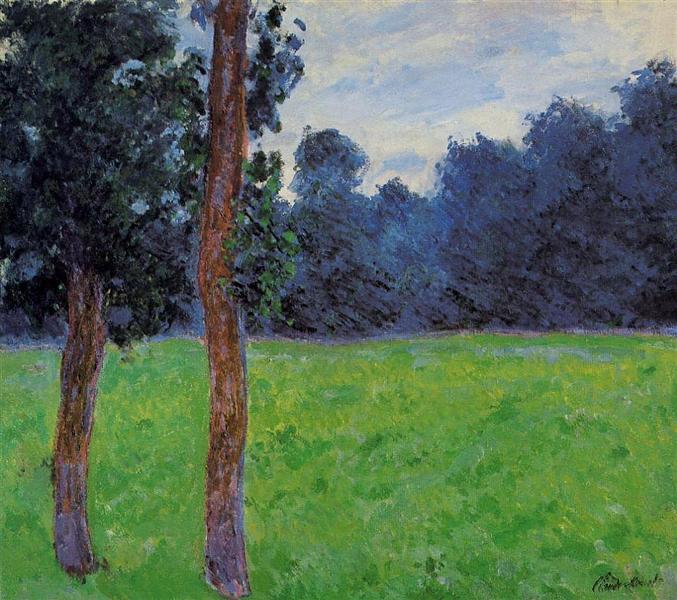Description
The work "Two trees in a meadow" (1886) by Claude Monet is at a crucial point of his career, representing not only his mastery in capturing light and color, but also his intimate connection with nature. As one of the main exponents of the impressionist movement, Monet causes a deep reflection on the interaction between the environment and the perception of the artist. In this painting, we observe the serenity of a rural landscape where two trees dominate space, evoking a feeling of tranquility.
The composition of the work is structured around these two trees, which rise gracefully to the sky, and are surrounded by a vast and wavy field. The configuration of the trees in the foreground adds depth to the work, while establishing a direct connection with the viewer by inviting him to contemplate the scene. The choice to place the trees in a central position, balanced by the extension of the grass that surrounds them, suggests a meditation on permanence in front of the transience of life. Monet captures this ephemeral moment and transforms it into a visual testimony through its brilliant color use.
In fact, the color palette that Monet uses in "two trees in a meadow" is remarkably fresh and vibrant. The Greens of the Prado are combined with nuances of blue and warm yellow, creating a visual effect that evokes the sensation of a light and sunny day. This display of shades is reflected in the loose and rapid technique of the characteristic monet brush, which serves to transmit both the atmosphere and the light that is transmitted through the leaves of the trees. This almost tactile approach highlights the impressionist aspect of his work, where immediate perception and transience are recurrent issues.
In "two trees in a meadow", Monet moves away from the detailed and exact representation, in favor of capturing the essence of the landscape. There are no human figures in painting; The absence of characters emphasizes the lonely character of the scene and allows the viewer to contemplate nature in its purest state. This also reinforces the idea that the landscape has a value in itself, without the need for the intervention of humanity.
The work is part of a period in which Monet experimented with light and color in rural landscapes, an issue that used to recurrent throughout his career. Contemporary works such as "Impression, Rising Sun" (1872) and "Los Nenúfares" (1889-1926) demonstrate a continuous interest in the light and its effect on nature. Through these works, Monet established a constant dialogue with its surroundings, which is evident in "two trees in a meadow", where each brushstroke on the canvas feels almost like a whisper of nature itself.
In conclusion, "two trees in a meadow" is a masterpiece that encapsulates the essence of impressionism. Through its careful and vibrant composition, delicate color use, and a nostalgic perspective that excludes the human figure, Monet invites the viewer to a deepest appreciation of nature. Painting is not only a testimony of the artist's exceptional talent, but also a reflection of his philosophy on the relationship of the human being with the natural world that surrounds him. With each observation, the viewer discovers new nuances, lights of light and color confirming Claude Monet's genius in his attempt to capture the ephemeral.
KUADROS ©, a famous paint on your wall.
Hand-made oil painting reproductions, with the quality of professional artists and the distinctive seal of KUADROS ©.
Reproduction service paintings With a guarantee of satisfaction. If you are not completely satisfied with the replica of your painting, we refund your money 100%.

